Essay on Managing Effective Organizations: Diversity, Ethics, and OB
VerifiedAdded on 2020/05/28
|11
|3121
|140
Essay
AI Summary
This essay delves into the critical aspects of organizational behavior, specifically focusing on diversity management and ethical considerations within a multinational corporation. It uses the Social Identity Theory to analyze challenges arising from cultural differences, such as communication barriers and discrimination, and proposes solutions to foster inclusivity. Furthermore, the essay explores ethical issues like nepotism, using the Justice Based Ethical Theory to highlight the importance of fairness, equity, and impartiality in organizational practices. The author provides real-life examples, analyzes them through the lens of these theories, and suggests strategies for creating a more equitable and productive work environment. The essay emphasizes the need for diversity training, open communication, and adherence to ethical principles to enhance employee satisfaction and organizational success.
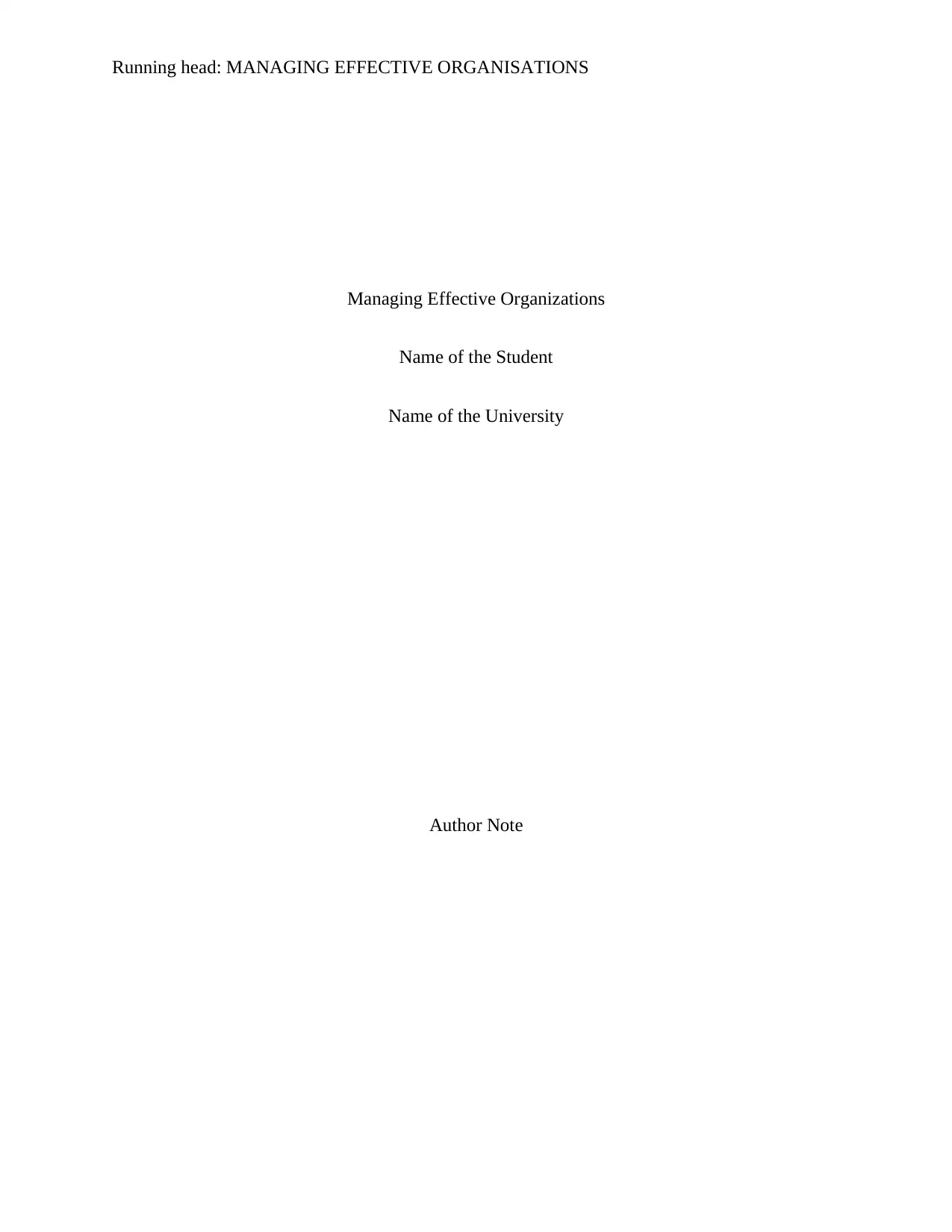
Running head: MANAGING EFFECTIVE ORGANISATIONS
Managing Effective Organizations
Name of the Student
Name of the University
Author Note
Managing Effective Organizations
Name of the Student
Name of the University
Author Note
Paraphrase This Document
Need a fresh take? Get an instant paraphrase of this document with our AI Paraphraser
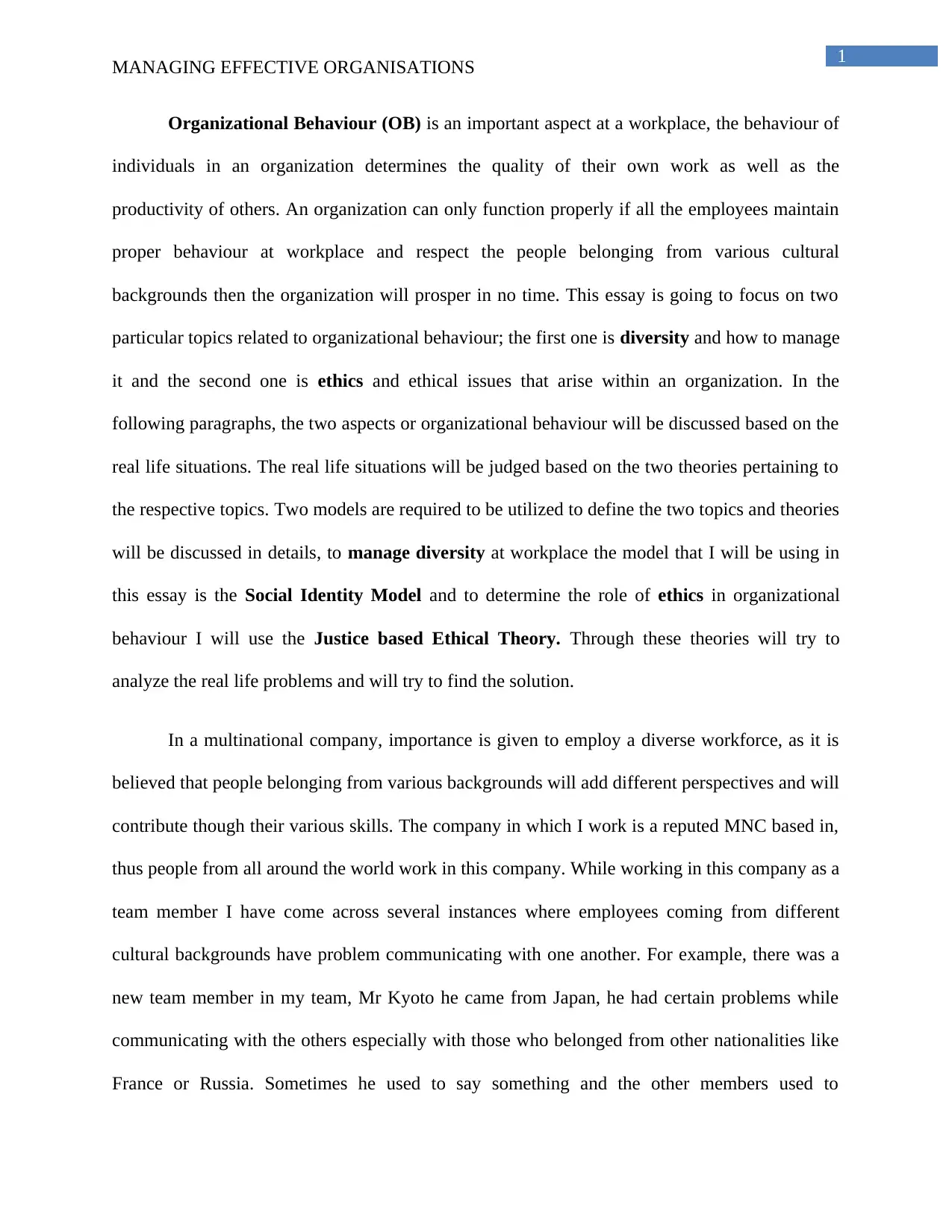
1
MANAGING EFFECTIVE ORGANISATIONS
Organizational Behaviour (OB) is an important aspect at a workplace, the behaviour of
individuals in an organization determines the quality of their own work as well as the
productivity of others. An organization can only function properly if all the employees maintain
proper behaviour at workplace and respect the people belonging from various cultural
backgrounds then the organization will prosper in no time. This essay is going to focus on two
particular topics related to organizational behaviour; the first one is diversity and how to manage
it and the second one is ethics and ethical issues that arise within an organization. In the
following paragraphs, the two aspects or organizational behaviour will be discussed based on the
real life situations. The real life situations will be judged based on the two theories pertaining to
the respective topics. Two models are required to be utilized to define the two topics and theories
will be discussed in details, to manage diversity at workplace the model that I will be using in
this essay is the Social Identity Model and to determine the role of ethics in organizational
behaviour I will use the Justice based Ethical Theory. Through these theories will try to
analyze the real life problems and will try to find the solution.
In a multinational company, importance is given to employ a diverse workforce, as it is
believed that people belonging from various backgrounds will add different perspectives and will
contribute though their various skills. The company in which I work is a reputed MNC based in,
thus people from all around the world work in this company. While working in this company as a
team member I have come across several instances where employees coming from different
cultural backgrounds have problem communicating with one another. For example, there was a
new team member in my team, Mr Kyoto he came from Japan, he had certain problems while
communicating with the others especially with those who belonged from other nationalities like
France or Russia. Sometimes he used to say something and the other members used to
MANAGING EFFECTIVE ORGANISATIONS
Organizational Behaviour (OB) is an important aspect at a workplace, the behaviour of
individuals in an organization determines the quality of their own work as well as the
productivity of others. An organization can only function properly if all the employees maintain
proper behaviour at workplace and respect the people belonging from various cultural
backgrounds then the organization will prosper in no time. This essay is going to focus on two
particular topics related to organizational behaviour; the first one is diversity and how to manage
it and the second one is ethics and ethical issues that arise within an organization. In the
following paragraphs, the two aspects or organizational behaviour will be discussed based on the
real life situations. The real life situations will be judged based on the two theories pertaining to
the respective topics. Two models are required to be utilized to define the two topics and theories
will be discussed in details, to manage diversity at workplace the model that I will be using in
this essay is the Social Identity Model and to determine the role of ethics in organizational
behaviour I will use the Justice based Ethical Theory. Through these theories will try to
analyze the real life problems and will try to find the solution.
In a multinational company, importance is given to employ a diverse workforce, as it is
believed that people belonging from various backgrounds will add different perspectives and will
contribute though their various skills. The company in which I work is a reputed MNC based in,
thus people from all around the world work in this company. While working in this company as a
team member I have come across several instances where employees coming from different
cultural backgrounds have problem communicating with one another. For example, there was a
new team member in my team, Mr Kyoto he came from Japan, he had certain problems while
communicating with the others especially with those who belonged from other nationalities like
France or Russia. Sometimes he used to say something and the other members used to
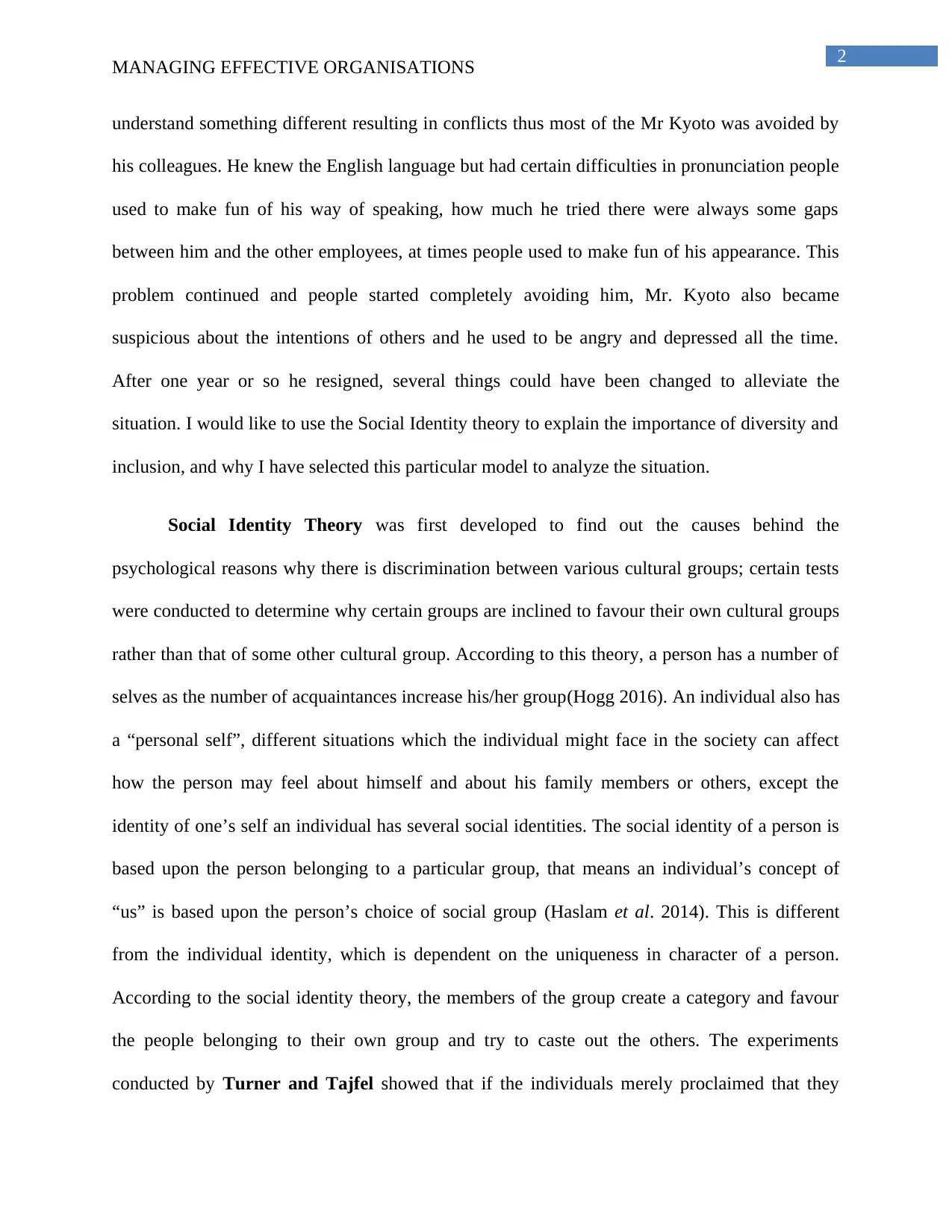
2
MANAGING EFFECTIVE ORGANISATIONS
understand something different resulting in conflicts thus most of the Mr Kyoto was avoided by
his colleagues. He knew the English language but had certain difficulties in pronunciation people
used to make fun of his way of speaking, how much he tried there were always some gaps
between him and the other employees, at times people used to make fun of his appearance. This
problem continued and people started completely avoiding him, Mr. Kyoto also became
suspicious about the intentions of others and he used to be angry and depressed all the time.
After one year or so he resigned, several things could have been changed to alleviate the
situation. I would like to use the Social Identity theory to explain the importance of diversity and
inclusion, and why I have selected this particular model to analyze the situation.
Social Identity Theory was first developed to find out the causes behind the
psychological reasons why there is discrimination between various cultural groups; certain tests
were conducted to determine why certain groups are inclined to favour their own cultural groups
rather than that of some other cultural group. According to this theory, a person has a number of
selves as the number of acquaintances increase his/her group(Hogg 2016). An individual also has
a “personal self”, different situations which the individual might face in the society can affect
how the person may feel about himself and about his family members or others, except the
identity of one’s self an individual has several social identities. The social identity of a person is
based upon the person belonging to a particular group, that means an individual’s concept of
“us” is based upon the person’s choice of social group (Haslam et al. 2014). This is different
from the individual identity, which is dependent on the uniqueness in character of a person.
According to the social identity theory, the members of the group create a category and favour
the people belonging to their own group and try to caste out the others. The experiments
conducted by Turner and Tajfel showed that if the individuals merely proclaimed that they
MANAGING EFFECTIVE ORGANISATIONS
understand something different resulting in conflicts thus most of the Mr Kyoto was avoided by
his colleagues. He knew the English language but had certain difficulties in pronunciation people
used to make fun of his way of speaking, how much he tried there were always some gaps
between him and the other employees, at times people used to make fun of his appearance. This
problem continued and people started completely avoiding him, Mr. Kyoto also became
suspicious about the intentions of others and he used to be angry and depressed all the time.
After one year or so he resigned, several things could have been changed to alleviate the
situation. I would like to use the Social Identity theory to explain the importance of diversity and
inclusion, and why I have selected this particular model to analyze the situation.
Social Identity Theory was first developed to find out the causes behind the
psychological reasons why there is discrimination between various cultural groups; certain tests
were conducted to determine why certain groups are inclined to favour their own cultural groups
rather than that of some other cultural group. According to this theory, a person has a number of
selves as the number of acquaintances increase his/her group(Hogg 2016). An individual also has
a “personal self”, different situations which the individual might face in the society can affect
how the person may feel about himself and about his family members or others, except the
identity of one’s self an individual has several social identities. The social identity of a person is
based upon the person belonging to a particular group, that means an individual’s concept of
“us” is based upon the person’s choice of social group (Haslam et al. 2014). This is different
from the individual identity, which is dependent on the uniqueness in character of a person.
According to the social identity theory, the members of the group create a category and favour
the people belonging to their own group and try to caste out the others. The experiments
conducted by Turner and Tajfel showed that if the individuals merely proclaimed that they
⊘ This is a preview!⊘
Do you want full access?
Subscribe today to unlock all pages.

Trusted by 1+ million students worldwide
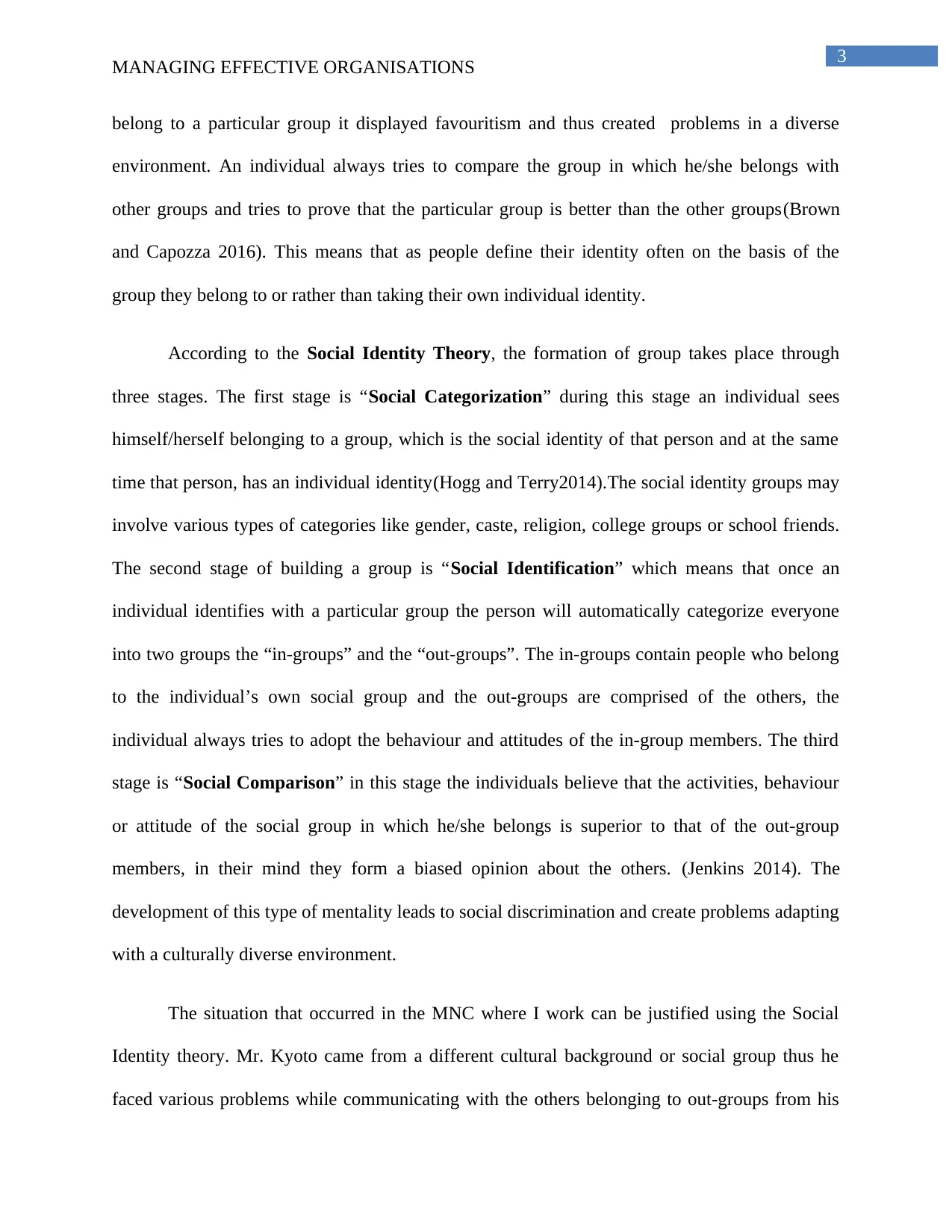
3
MANAGING EFFECTIVE ORGANISATIONS
belong to a particular group it displayed favouritism and thus created problems in a diverse
environment. An individual always tries to compare the group in which he/she belongs with
other groups and tries to prove that the particular group is better than the other groups(Brown
and Capozza 2016). This means that as people define their identity often on the basis of the
group they belong to or rather than taking their own individual identity.
According to the Social Identity Theory, the formation of group takes place through
three stages. The first stage is “Social Categorization” during this stage an individual sees
himself/herself belonging to a group, which is the social identity of that person and at the same
time that person, has an individual identity(Hogg and Terry2014).The social identity groups may
involve various types of categories like gender, caste, religion, college groups or school friends.
The second stage of building a group is “Social Identification” which means that once an
individual identifies with a particular group the person will automatically categorize everyone
into two groups the “in-groups” and the “out-groups”. The in-groups contain people who belong
to the individual’s own social group and the out-groups are comprised of the others, the
individual always tries to adopt the behaviour and attitudes of the in-group members. The third
stage is “Social Comparison” in this stage the individuals believe that the activities, behaviour
or attitude of the social group in which he/she belongs is superior to that of the out-group
members, in their mind they form a biased opinion about the others. (Jenkins 2014). The
development of this type of mentality leads to social discrimination and create problems adapting
with a culturally diverse environment.
The situation that occurred in the MNC where I work can be justified using the Social
Identity theory. Mr. Kyoto came from a different cultural background or social group thus he
faced various problems while communicating with the others belonging to out-groups from his
MANAGING EFFECTIVE ORGANISATIONS
belong to a particular group it displayed favouritism and thus created problems in a diverse
environment. An individual always tries to compare the group in which he/she belongs with
other groups and tries to prove that the particular group is better than the other groups(Brown
and Capozza 2016). This means that as people define their identity often on the basis of the
group they belong to or rather than taking their own individual identity.
According to the Social Identity Theory, the formation of group takes place through
three stages. The first stage is “Social Categorization” during this stage an individual sees
himself/herself belonging to a group, which is the social identity of that person and at the same
time that person, has an individual identity(Hogg and Terry2014).The social identity groups may
involve various types of categories like gender, caste, religion, college groups or school friends.
The second stage of building a group is “Social Identification” which means that once an
individual identifies with a particular group the person will automatically categorize everyone
into two groups the “in-groups” and the “out-groups”. The in-groups contain people who belong
to the individual’s own social group and the out-groups are comprised of the others, the
individual always tries to adopt the behaviour and attitudes of the in-group members. The third
stage is “Social Comparison” in this stage the individuals believe that the activities, behaviour
or attitude of the social group in which he/she belongs is superior to that of the out-group
members, in their mind they form a biased opinion about the others. (Jenkins 2014). The
development of this type of mentality leads to social discrimination and create problems adapting
with a culturally diverse environment.
The situation that occurred in the MNC where I work can be justified using the Social
Identity theory. Mr. Kyoto came from a different cultural background or social group thus he
faced various problems while communicating with the others belonging to out-groups from his
Paraphrase This Document
Need a fresh take? Get an instant paraphrase of this document with our AI Paraphraser
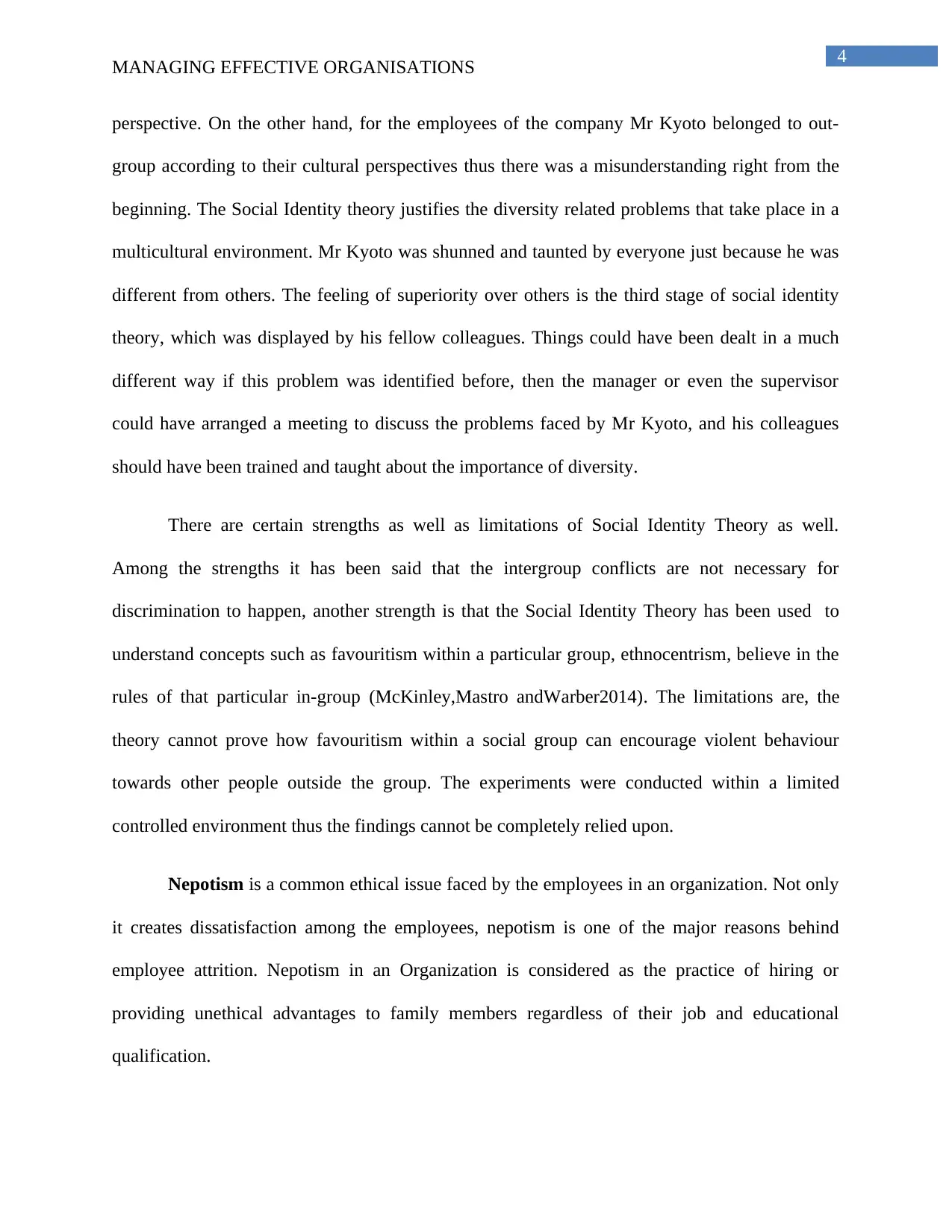
4
MANAGING EFFECTIVE ORGANISATIONS
perspective. On the other hand, for the employees of the company Mr Kyoto belonged to out-
group according to their cultural perspectives thus there was a misunderstanding right from the
beginning. The Social Identity theory justifies the diversity related problems that take place in a
multicultural environment. Mr Kyoto was shunned and taunted by everyone just because he was
different from others. The feeling of superiority over others is the third stage of social identity
theory, which was displayed by his fellow colleagues. Things could have been dealt in a much
different way if this problem was identified before, then the manager or even the supervisor
could have arranged a meeting to discuss the problems faced by Mr Kyoto, and his colleagues
should have been trained and taught about the importance of diversity.
There are certain strengths as well as limitations of Social Identity Theory as well.
Among the strengths it has been said that the intergroup conflicts are not necessary for
discrimination to happen, another strength is that the Social Identity Theory has been used to
understand concepts such as favouritism within a particular group, ethnocentrism, believe in the
rules of that particular in-group (McKinley,Mastro andWarber2014). The limitations are, the
theory cannot prove how favouritism within a social group can encourage violent behaviour
towards other people outside the group. The experiments were conducted within a limited
controlled environment thus the findings cannot be completely relied upon.
Nepotism is a common ethical issue faced by the employees in an organization. Not only
it creates dissatisfaction among the employees, nepotism is one of the major reasons behind
employee attrition. Nepotism in an Organization is considered as the practice of hiring or
providing unethical advantages to family members regardless of their job and educational
qualification.
MANAGING EFFECTIVE ORGANISATIONS
perspective. On the other hand, for the employees of the company Mr Kyoto belonged to out-
group according to their cultural perspectives thus there was a misunderstanding right from the
beginning. The Social Identity theory justifies the diversity related problems that take place in a
multicultural environment. Mr Kyoto was shunned and taunted by everyone just because he was
different from others. The feeling of superiority over others is the third stage of social identity
theory, which was displayed by his fellow colleagues. Things could have been dealt in a much
different way if this problem was identified before, then the manager or even the supervisor
could have arranged a meeting to discuss the problems faced by Mr Kyoto, and his colleagues
should have been trained and taught about the importance of diversity.
There are certain strengths as well as limitations of Social Identity Theory as well.
Among the strengths it has been said that the intergroup conflicts are not necessary for
discrimination to happen, another strength is that the Social Identity Theory has been used to
understand concepts such as favouritism within a particular group, ethnocentrism, believe in the
rules of that particular in-group (McKinley,Mastro andWarber2014). The limitations are, the
theory cannot prove how favouritism within a social group can encourage violent behaviour
towards other people outside the group. The experiments were conducted within a limited
controlled environment thus the findings cannot be completely relied upon.
Nepotism is a common ethical issue faced by the employees in an organization. Not only
it creates dissatisfaction among the employees, nepotism is one of the major reasons behind
employee attrition. Nepotism in an Organization is considered as the practice of hiring or
providing unethical advantages to family members regardless of their job and educational
qualification.
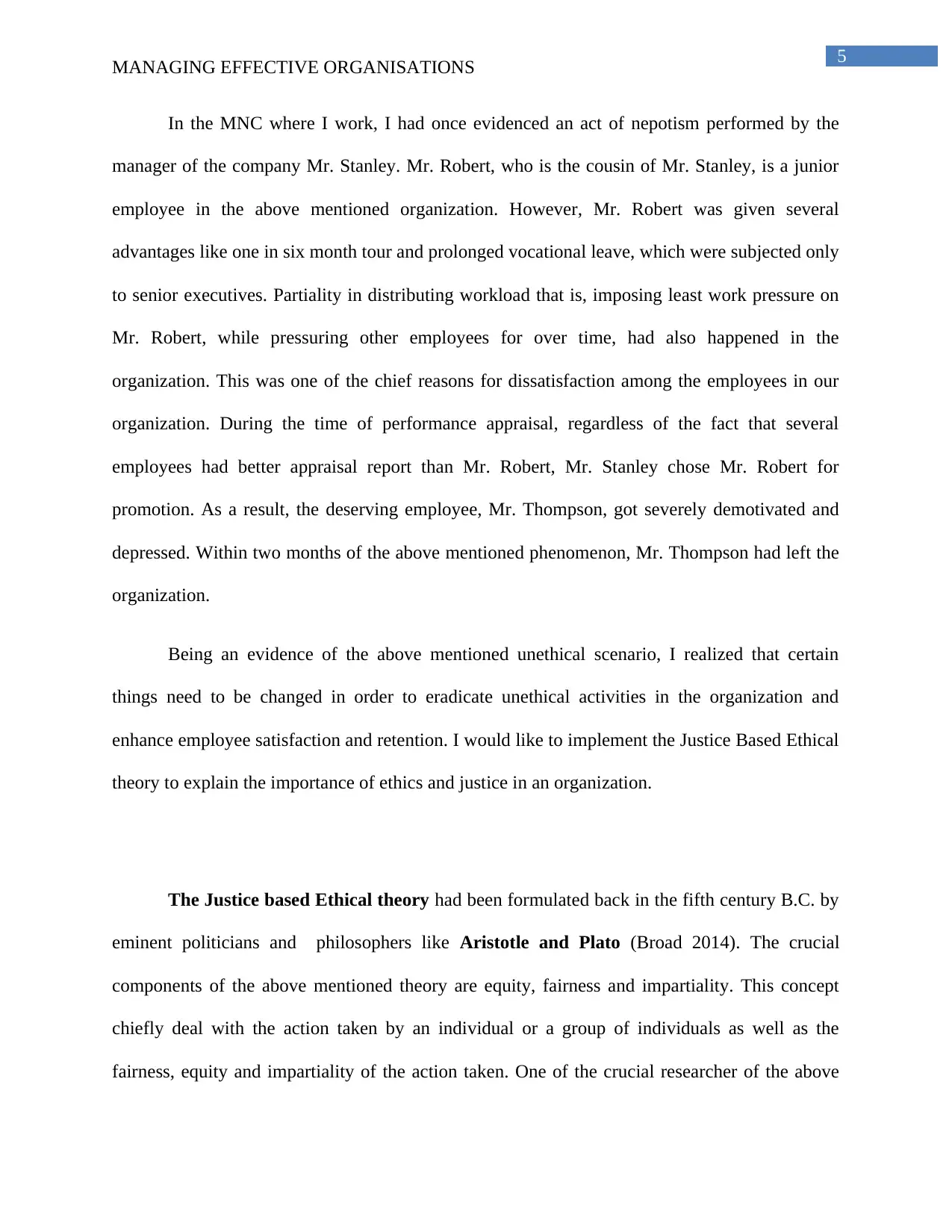
5
MANAGING EFFECTIVE ORGANISATIONS
In the MNC where I work, I had once evidenced an act of nepotism performed by the
manager of the company Mr. Stanley. Mr. Robert, who is the cousin of Mr. Stanley, is a junior
employee in the above mentioned organization. However, Mr. Robert was given several
advantages like one in six month tour and prolonged vocational leave, which were subjected only
to senior executives. Partiality in distributing workload that is, imposing least work pressure on
Mr. Robert, while pressuring other employees for over time, had also happened in the
organization. This was one of the chief reasons for dissatisfaction among the employees in our
organization. During the time of performance appraisal, regardless of the fact that several
employees had better appraisal report than Mr. Robert, Mr. Stanley chose Mr. Robert for
promotion. As a result, the deserving employee, Mr. Thompson, got severely demotivated and
depressed. Within two months of the above mentioned phenomenon, Mr. Thompson had left the
organization.
Being an evidence of the above mentioned unethical scenario, I realized that certain
things need to be changed in order to eradicate unethical activities in the organization and
enhance employee satisfaction and retention. I would like to implement the Justice Based Ethical
theory to explain the importance of ethics and justice in an organization.
The Justice based Ethical theory had been formulated back in the fifth century B.C. by
eminent politicians and philosophers like Aristotle and Plato (Broad 2014). The crucial
components of the above mentioned theory are equity, fairness and impartiality. This concept
chiefly deal with the action taken by an individual or a group of individuals as well as the
fairness, equity and impartiality of the action taken. One of the crucial researcher of the above
MANAGING EFFECTIVE ORGANISATIONS
In the MNC where I work, I had once evidenced an act of nepotism performed by the
manager of the company Mr. Stanley. Mr. Robert, who is the cousin of Mr. Stanley, is a junior
employee in the above mentioned organization. However, Mr. Robert was given several
advantages like one in six month tour and prolonged vocational leave, which were subjected only
to senior executives. Partiality in distributing workload that is, imposing least work pressure on
Mr. Robert, while pressuring other employees for over time, had also happened in the
organization. This was one of the chief reasons for dissatisfaction among the employees in our
organization. During the time of performance appraisal, regardless of the fact that several
employees had better appraisal report than Mr. Robert, Mr. Stanley chose Mr. Robert for
promotion. As a result, the deserving employee, Mr. Thompson, got severely demotivated and
depressed. Within two months of the above mentioned phenomenon, Mr. Thompson had left the
organization.
Being an evidence of the above mentioned unethical scenario, I realized that certain
things need to be changed in order to eradicate unethical activities in the organization and
enhance employee satisfaction and retention. I would like to implement the Justice Based Ethical
theory to explain the importance of ethics and justice in an organization.
The Justice based Ethical theory had been formulated back in the fifth century B.C. by
eminent politicians and philosophers like Aristotle and Plato (Broad 2014). The crucial
components of the above mentioned theory are equity, fairness and impartiality. This concept
chiefly deal with the action taken by an individual or a group of individuals as well as the
fairness, equity and impartiality of the action taken. One of the crucial researcher of the above
⊘ This is a preview!⊘
Do you want full access?
Subscribe today to unlock all pages.

Trusted by 1+ million students worldwide
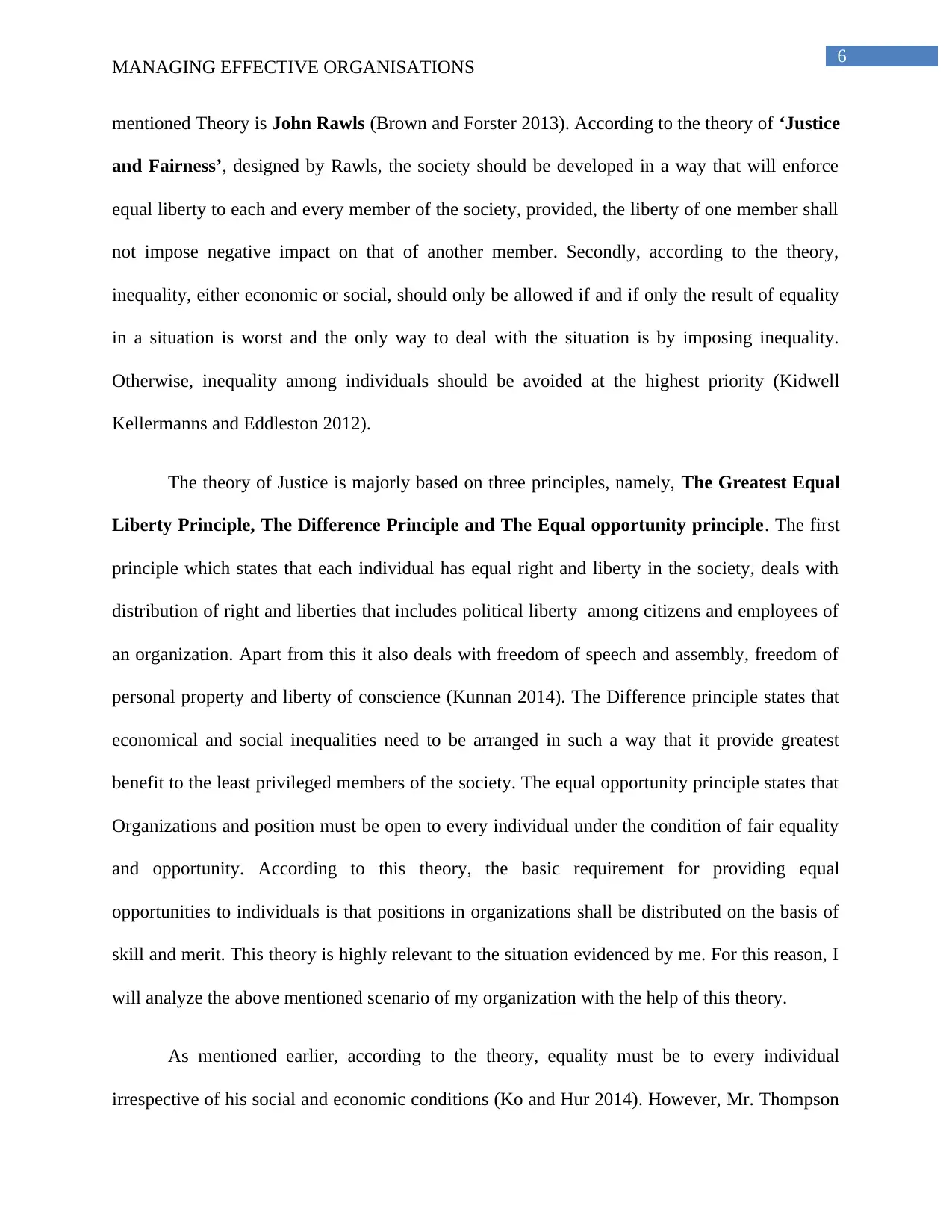
6
MANAGING EFFECTIVE ORGANISATIONS
mentioned Theory is John Rawls (Brown and Forster 2013). According to the theory of ‘Justice
and Fairness’, designed by Rawls, the society should be developed in a way that will enforce
equal liberty to each and every member of the society, provided, the liberty of one member shall
not impose negative impact on that of another member. Secondly, according to the theory,
inequality, either economic or social, should only be allowed if and if only the result of equality
in a situation is worst and the only way to deal with the situation is by imposing inequality.
Otherwise, inequality among individuals should be avoided at the highest priority (Kidwell
Kellermanns and Eddleston 2012).
The theory of Justice is majorly based on three principles, namely, The Greatest Equal
Liberty Principle, The Difference Principle and The Equal opportunity principle. The first
principle which states that each individual has equal right and liberty in the society, deals with
distribution of right and liberties that includes political liberty among citizens and employees of
an organization. Apart from this it also deals with freedom of speech and assembly, freedom of
personal property and liberty of conscience (Kunnan 2014). The Difference principle states that
economical and social inequalities need to be arranged in such a way that it provide greatest
benefit to the least privileged members of the society. The equal opportunity principle states that
Organizations and position must be open to every individual under the condition of fair equality
and opportunity. According to this theory, the basic requirement for providing equal
opportunities to individuals is that positions in organizations shall be distributed on the basis of
skill and merit. This theory is highly relevant to the situation evidenced by me. For this reason, I
will analyze the above mentioned scenario of my organization with the help of this theory.
As mentioned earlier, according to the theory, equality must be to every individual
irrespective of his social and economic conditions (Ko and Hur 2014). However, Mr. Thompson
MANAGING EFFECTIVE ORGANISATIONS
mentioned Theory is John Rawls (Brown and Forster 2013). According to the theory of ‘Justice
and Fairness’, designed by Rawls, the society should be developed in a way that will enforce
equal liberty to each and every member of the society, provided, the liberty of one member shall
not impose negative impact on that of another member. Secondly, according to the theory,
inequality, either economic or social, should only be allowed if and if only the result of equality
in a situation is worst and the only way to deal with the situation is by imposing inequality.
Otherwise, inequality among individuals should be avoided at the highest priority (Kidwell
Kellermanns and Eddleston 2012).
The theory of Justice is majorly based on three principles, namely, The Greatest Equal
Liberty Principle, The Difference Principle and The Equal opportunity principle. The first
principle which states that each individual has equal right and liberty in the society, deals with
distribution of right and liberties that includes political liberty among citizens and employees of
an organization. Apart from this it also deals with freedom of speech and assembly, freedom of
personal property and liberty of conscience (Kunnan 2014). The Difference principle states that
economical and social inequalities need to be arranged in such a way that it provide greatest
benefit to the least privileged members of the society. The equal opportunity principle states that
Organizations and position must be open to every individual under the condition of fair equality
and opportunity. According to this theory, the basic requirement for providing equal
opportunities to individuals is that positions in organizations shall be distributed on the basis of
skill and merit. This theory is highly relevant to the situation evidenced by me. For this reason, I
will analyze the above mentioned scenario of my organization with the help of this theory.
As mentioned earlier, according to the theory, equality must be to every individual
irrespective of his social and economic conditions (Ko and Hur 2014). However, Mr. Thompson
Paraphrase This Document
Need a fresh take? Get an instant paraphrase of this document with our AI Paraphraser
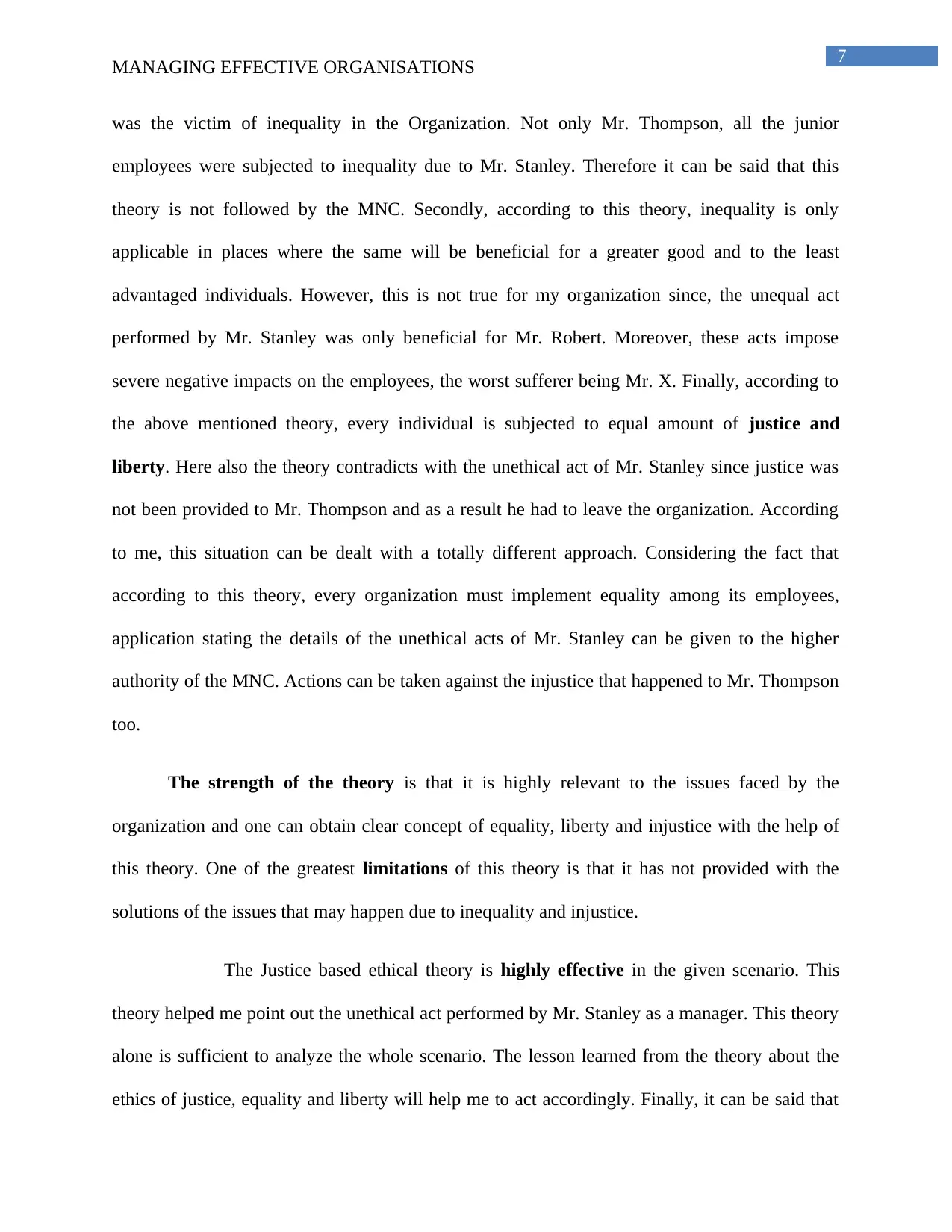
7
MANAGING EFFECTIVE ORGANISATIONS
was the victim of inequality in the Organization. Not only Mr. Thompson, all the junior
employees were subjected to inequality due to Mr. Stanley. Therefore it can be said that this
theory is not followed by the MNC. Secondly, according to this theory, inequality is only
applicable in places where the same will be beneficial for a greater good and to the least
advantaged individuals. However, this is not true for my organization since, the unequal act
performed by Mr. Stanley was only beneficial for Mr. Robert. Moreover, these acts impose
severe negative impacts on the employees, the worst sufferer being Mr. X. Finally, according to
the above mentioned theory, every individual is subjected to equal amount of justice and
liberty. Here also the theory contradicts with the unethical act of Mr. Stanley since justice was
not been provided to Mr. Thompson and as a result he had to leave the organization. According
to me, this situation can be dealt with a totally different approach. Considering the fact that
according to this theory, every organization must implement equality among its employees,
application stating the details of the unethical acts of Mr. Stanley can be given to the higher
authority of the MNC. Actions can be taken against the injustice that happened to Mr. Thompson
too.
The strength of the theory is that it is highly relevant to the issues faced by the
organization and one can obtain clear concept of equality, liberty and injustice with the help of
this theory. One of the greatest limitations of this theory is that it has not provided with the
solutions of the issues that may happen due to inequality and injustice.
The Justice based ethical theory is highly effective in the given scenario. This
theory helped me point out the unethical act performed by Mr. Stanley as a manager. This theory
alone is sufficient to analyze the whole scenario. The lesson learned from the theory about the
ethics of justice, equality and liberty will help me to act accordingly. Finally, it can be said that
MANAGING EFFECTIVE ORGANISATIONS
was the victim of inequality in the Organization. Not only Mr. Thompson, all the junior
employees were subjected to inequality due to Mr. Stanley. Therefore it can be said that this
theory is not followed by the MNC. Secondly, according to this theory, inequality is only
applicable in places where the same will be beneficial for a greater good and to the least
advantaged individuals. However, this is not true for my organization since, the unequal act
performed by Mr. Stanley was only beneficial for Mr. Robert. Moreover, these acts impose
severe negative impacts on the employees, the worst sufferer being Mr. X. Finally, according to
the above mentioned theory, every individual is subjected to equal amount of justice and
liberty. Here also the theory contradicts with the unethical act of Mr. Stanley since justice was
not been provided to Mr. Thompson and as a result he had to leave the organization. According
to me, this situation can be dealt with a totally different approach. Considering the fact that
according to this theory, every organization must implement equality among its employees,
application stating the details of the unethical acts of Mr. Stanley can be given to the higher
authority of the MNC. Actions can be taken against the injustice that happened to Mr. Thompson
too.
The strength of the theory is that it is highly relevant to the issues faced by the
organization and one can obtain clear concept of equality, liberty and injustice with the help of
this theory. One of the greatest limitations of this theory is that it has not provided with the
solutions of the issues that may happen due to inequality and injustice.
The Justice based ethical theory is highly effective in the given scenario. This
theory helped me point out the unethical act performed by Mr. Stanley as a manager. This theory
alone is sufficient to analyze the whole scenario. The lesson learned from the theory about the
ethics of justice, equality and liberty will help me to act accordingly. Finally, it can be said that
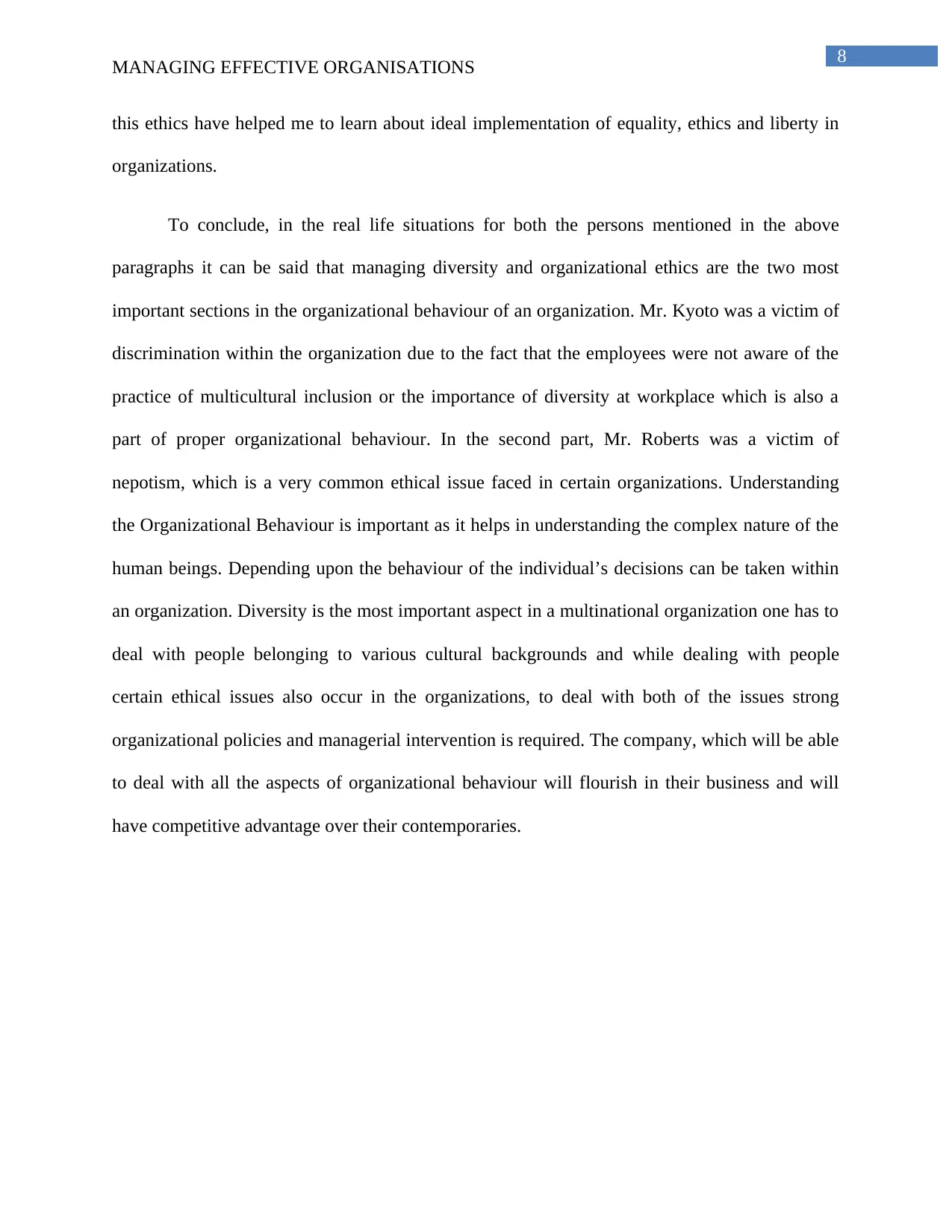
8
MANAGING EFFECTIVE ORGANISATIONS
this ethics have helped me to learn about ideal implementation of equality, ethics and liberty in
organizations.
To conclude, in the real life situations for both the persons mentioned in the above
paragraphs it can be said that managing diversity and organizational ethics are the two most
important sections in the organizational behaviour of an organization. Mr. Kyoto was a victim of
discrimination within the organization due to the fact that the employees were not aware of the
practice of multicultural inclusion or the importance of diversity at workplace which is also a
part of proper organizational behaviour. In the second part, Mr. Roberts was a victim of
nepotism, which is a very common ethical issue faced in certain organizations. Understanding
the Organizational Behaviour is important as it helps in understanding the complex nature of the
human beings. Depending upon the behaviour of the individual’s decisions can be taken within
an organization. Diversity is the most important aspect in a multinational organization one has to
deal with people belonging to various cultural backgrounds and while dealing with people
certain ethical issues also occur in the organizations, to deal with both of the issues strong
organizational policies and managerial intervention is required. The company, which will be able
to deal with all the aspects of organizational behaviour will flourish in their business and will
have competitive advantage over their contemporaries.
MANAGING EFFECTIVE ORGANISATIONS
this ethics have helped me to learn about ideal implementation of equality, ethics and liberty in
organizations.
To conclude, in the real life situations for both the persons mentioned in the above
paragraphs it can be said that managing diversity and organizational ethics are the two most
important sections in the organizational behaviour of an organization. Mr. Kyoto was a victim of
discrimination within the organization due to the fact that the employees were not aware of the
practice of multicultural inclusion or the importance of diversity at workplace which is also a
part of proper organizational behaviour. In the second part, Mr. Roberts was a victim of
nepotism, which is a very common ethical issue faced in certain organizations. Understanding
the Organizational Behaviour is important as it helps in understanding the complex nature of the
human beings. Depending upon the behaviour of the individual’s decisions can be taken within
an organization. Diversity is the most important aspect in a multinational organization one has to
deal with people belonging to various cultural backgrounds and while dealing with people
certain ethical issues also occur in the organizations, to deal with both of the issues strong
organizational policies and managerial intervention is required. The company, which will be able
to deal with all the aspects of organizational behaviour will flourish in their business and will
have competitive advantage over their contemporaries.
⊘ This is a preview!⊘
Do you want full access?
Subscribe today to unlock all pages.

Trusted by 1+ million students worldwide
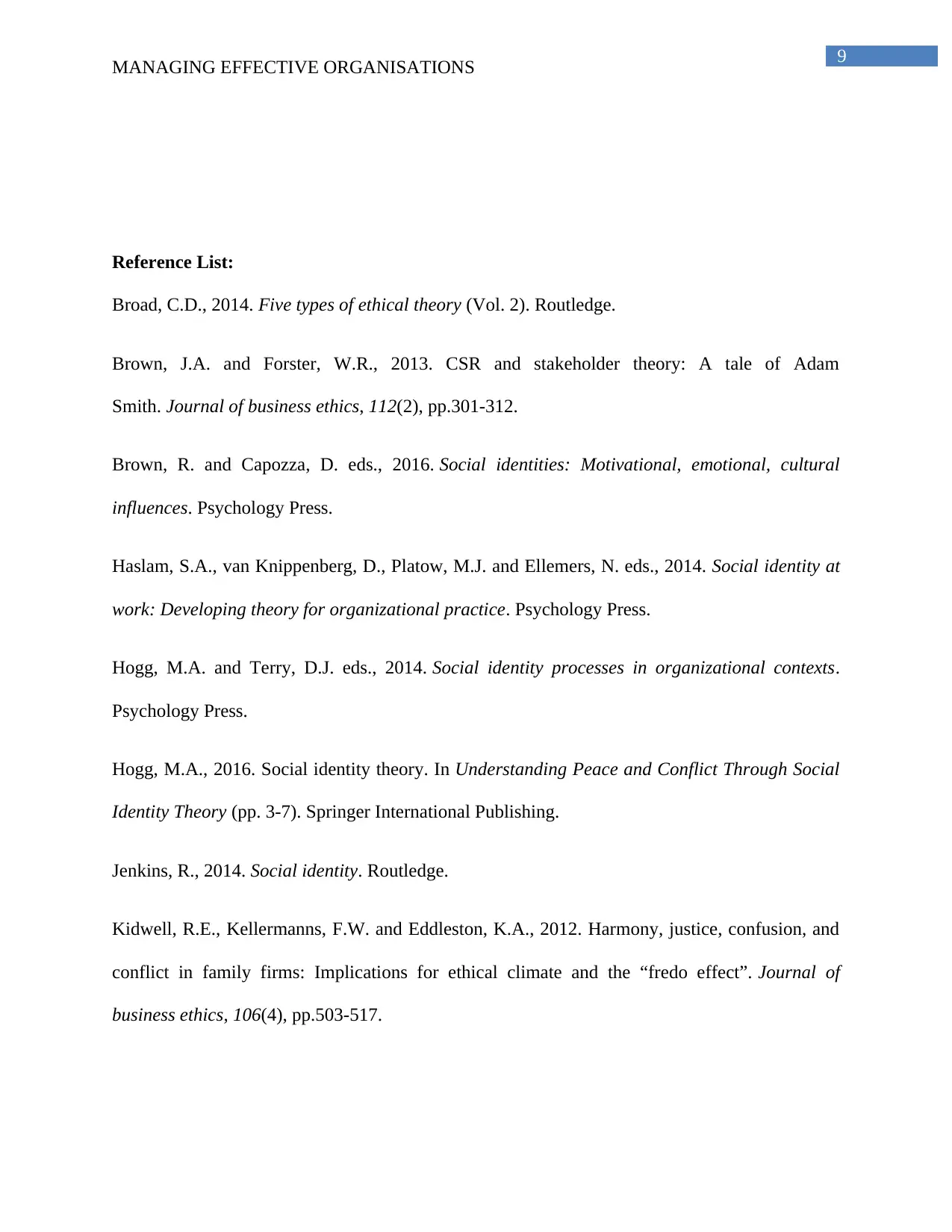
9
MANAGING EFFECTIVE ORGANISATIONS
Reference List:
Broad, C.D., 2014. Five types of ethical theory (Vol. 2). Routledge.
Brown, J.A. and Forster, W.R., 2013. CSR and stakeholder theory: A tale of Adam
Smith. Journal of business ethics, 112(2), pp.301-312.
Brown, R. and Capozza, D. eds., 2016. Social identities: Motivational, emotional, cultural
influences. Psychology Press.
Haslam, S.A., van Knippenberg, D., Platow, M.J. and Ellemers, N. eds., 2014. Social identity at
work: Developing theory for organizational practice. Psychology Press.
Hogg, M.A. and Terry, D.J. eds., 2014. Social identity processes in organizational contexts.
Psychology Press.
Hogg, M.A., 2016. Social identity theory. In Understanding Peace and Conflict Through Social
Identity Theory (pp. 3-7). Springer International Publishing.
Jenkins, R., 2014. Social identity. Routledge.
Kidwell, R.E., Kellermanns, F.W. and Eddleston, K.A., 2012. Harmony, justice, confusion, and
conflict in family firms: Implications for ethical climate and the “fredo effect”. Journal of
business ethics, 106(4), pp.503-517.
MANAGING EFFECTIVE ORGANISATIONS
Reference List:
Broad, C.D., 2014. Five types of ethical theory (Vol. 2). Routledge.
Brown, J.A. and Forster, W.R., 2013. CSR and stakeholder theory: A tale of Adam
Smith. Journal of business ethics, 112(2), pp.301-312.
Brown, R. and Capozza, D. eds., 2016. Social identities: Motivational, emotional, cultural
influences. Psychology Press.
Haslam, S.A., van Knippenberg, D., Platow, M.J. and Ellemers, N. eds., 2014. Social identity at
work: Developing theory for organizational practice. Psychology Press.
Hogg, M.A. and Terry, D.J. eds., 2014. Social identity processes in organizational contexts.
Psychology Press.
Hogg, M.A., 2016. Social identity theory. In Understanding Peace and Conflict Through Social
Identity Theory (pp. 3-7). Springer International Publishing.
Jenkins, R., 2014. Social identity. Routledge.
Kidwell, R.E., Kellermanns, F.W. and Eddleston, K.A., 2012. Harmony, justice, confusion, and
conflict in family firms: Implications for ethical climate and the “fredo effect”. Journal of
business ethics, 106(4), pp.503-517.
Paraphrase This Document
Need a fresh take? Get an instant paraphrase of this document with our AI Paraphraser
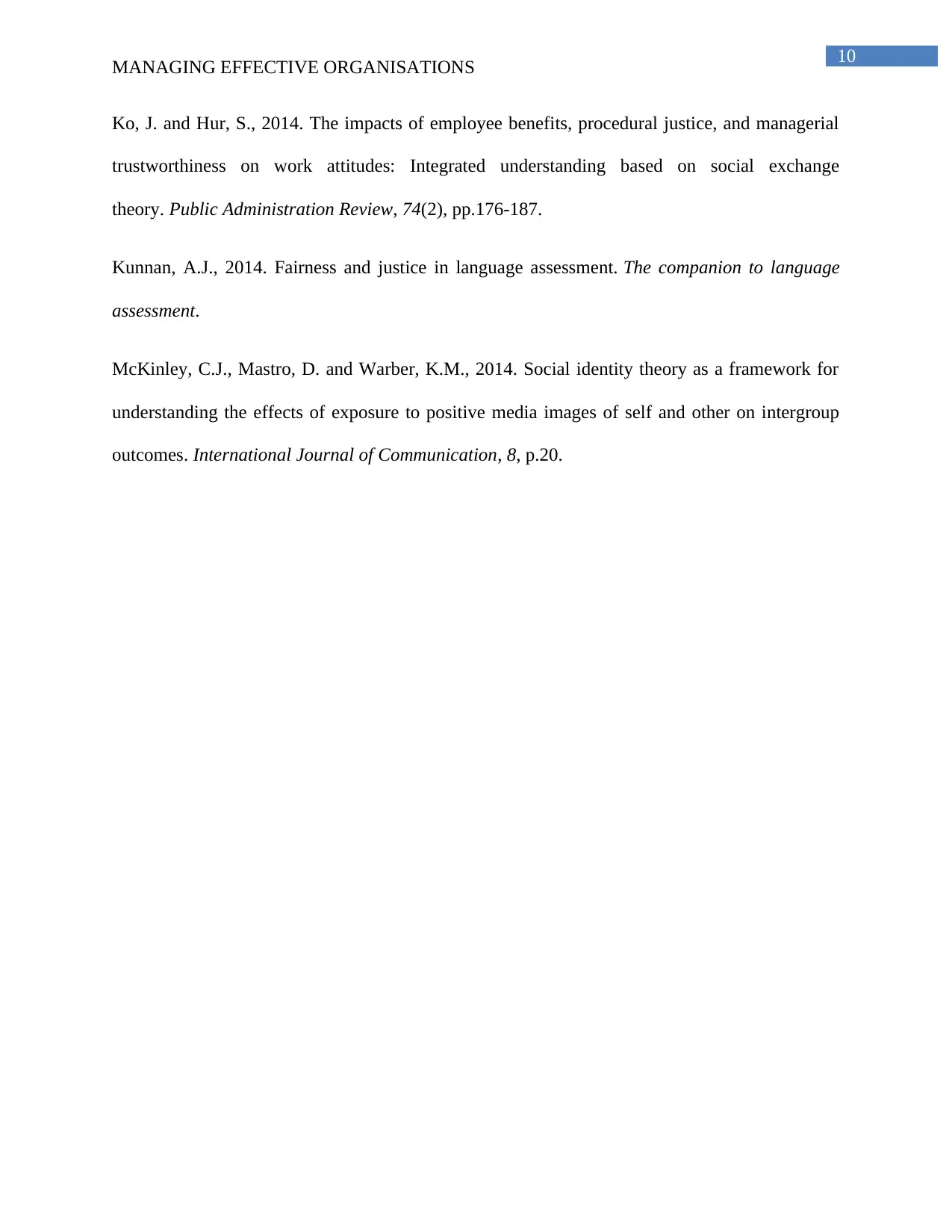
10
MANAGING EFFECTIVE ORGANISATIONS
Ko, J. and Hur, S., 2014. The impacts of employee benefits, procedural justice, and managerial
trustworthiness on work attitudes: Integrated understanding based on social exchange
theory. Public Administration Review, 74(2), pp.176-187.
Kunnan, A.J., 2014. Fairness and justice in language assessment. The companion to language
assessment.
McKinley, C.J., Mastro, D. and Warber, K.M., 2014. Social identity theory as a framework for
understanding the effects of exposure to positive media images of self and other on intergroup
outcomes. International Journal of Communication, 8, p.20.
MANAGING EFFECTIVE ORGANISATIONS
Ko, J. and Hur, S., 2014. The impacts of employee benefits, procedural justice, and managerial
trustworthiness on work attitudes: Integrated understanding based on social exchange
theory. Public Administration Review, 74(2), pp.176-187.
Kunnan, A.J., 2014. Fairness and justice in language assessment. The companion to language
assessment.
McKinley, C.J., Mastro, D. and Warber, K.M., 2014. Social identity theory as a framework for
understanding the effects of exposure to positive media images of self and other on intergroup
outcomes. International Journal of Communication, 8, p.20.
1 out of 11
Related Documents
Your All-in-One AI-Powered Toolkit for Academic Success.
+13062052269
info@desklib.com
Available 24*7 on WhatsApp / Email
![[object Object]](/_next/static/media/star-bottom.7253800d.svg)
Unlock your academic potential
Copyright © 2020–2025 A2Z Services. All Rights Reserved. Developed and managed by ZUCOL.





